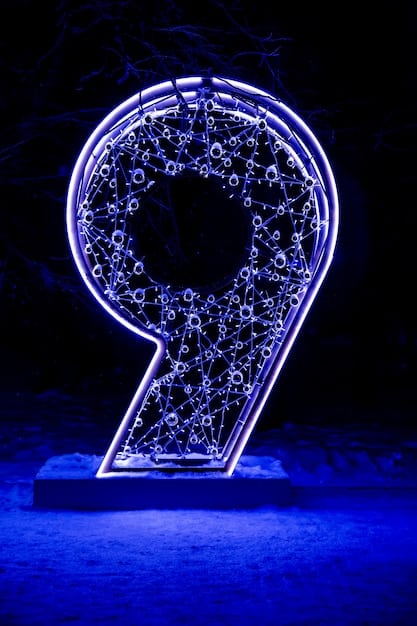Quantum Computing’s Impact on US Cybersecurity in 5 Years

The projected impact of quantum computing on US cybersecurity within the next five years is multifaceted, ranging from the potential to break current encryption standards to offering new, quantum-resistant cryptographic solutions, necessitating urgent strategic adaptation and significant investment in quantum-safe technologies and expert development.
As the digital landscape evolves at an unprecedented pace, a new frontier in computation is emerging: quantum computing. This revolutionary technology, with its promise of vastly superior processing power, holds implications for nearly every sector, none more critical than cybersecurity. Understanding the projected impact of Quantum Computing Leaps Forward: What’s the Projected Impact on US Cybersecurity in the Next 5 Years? is paramount for national security, economic stability, and the protection of critical infrastructure.
The Quantum Computing Revolution: Beyond Bits and Bytes
Quantum computing fundamentally redefines how information is processed. Unlike classical computers that rely on bits representing 0 or 1, quantum computers leverage qubits, which can exist in multiple states simultaneously through superposition and entanglement. This capability allows them to tackle complex computational problems that are intractable for even the most powerful supercomputers today.
The theoretical underpinnings of quantum mechanics, once confined to physics laboratories, are now being harnessed to build machines with unparalleled computational power. This shift from classical to quantum computation is not merely an incremental improvement; it represents a paradigm shift that will reconfigure technological landscapes and, by extension, vulnerability landscapes in cybersecurity.
Understanding Quantum Principles for Cybersecurity
To grasp the cybersecurity implications, it’s essential to briefly touch upon the core principles:
- Superposition: A qubit can exist in a combination of states (0 and 1) simultaneously, allowing for parallel processing of information.
- Entanglement: Two or more qubits can become linked, sharing a connection even when physically separated. Measuring one instantly affects the other, enabling faster data processing.
- Quantum Tunneling: Particles can pass through energy barriers that classical physics would deem insurmountable, potentially impacting cryptographic key generation.
These principles enable quantum algorithms like Shor’s and Grover’s, which are particularly relevant to cybersecurity. Shor’s algorithm, for instance, can factor large numbers exponentially faster than classical algorithms, a capability that directly threatens much of today’s public-key cryptography.
The pace of development in quantum computing is accelerating. While truly fault-tolerant, large-scale quantum computers are still some years away, the “noisy intermediate-scale quantum” (NISQ) era is already here. These smaller, less stable quantum computers are proving the feasibility of quantum computation and laying the groundwork for more advanced systems. Investments are pouring in from governments and private enterprises, signaling a clear intent to move quantum technology rapidly from research labs to practical applications.
The next five years will likely see continued breakthroughs in qubit stability, error correction, and the development of new quantum algorithms. These advancements, even if not leading to a fully realized “quantum apocalypse,” will exert significant pressure on existing cybersecurity paradigms and force a strategic re-evaluation within the US.
Immediate Threats: The Post-Quantum Cryptography Imperative
The most immediate and widely discussed threat quantum computing poses to US cybersecurity centers on its ability to compromise current cryptographic standards. Public-key cryptography, the backbone of secure internet communication, financial transactions, and classified government data, relies on the mathematical difficulty of factoring large numbers or solving discrete logarithm problems.
Shor’s algorithm, if implemented on a sufficiently powerful quantum computer, could efficiently break widely used encryption schemes such as RSA and Elliptic Curve Cryptography (ECC). This would render vast swathes of encrypted data vulnerable, from banking details and personal communications to national security secrets and critical infrastructure control systems. The threat is not hypothetical; it’s a mathematically proven vulnerability waiting for the hardware to catch up.

The “Harvest Now, Decrypt Later” Threat
Even if a large-scale quantum computer capable of breaking current encryption isn’t fully operational today, adversaries can exploit a concept known as “Harvest Now, Decrypt Later.” This involves collecting vast amounts of encrypted data now, storing it, and then decrypting it once quantum computers are sufficiently powerful. This means sensitive information exchanged today could be compromised years down the line, posing a significant risk to long-term data security.
Consider:
- Classified government communications
- Intellectual property and trade secrets
- Personal health records and financial data
- Critical infrastructure schematics
All these types of data, if intercepted and stored, could be exposed when quantum decryption becomes feasible. This underscores the urgency of transitioning to post-quantum cryptography (PQC).
The Shift to Post-Quantum Cryptography (PQC)
Recognizing this impending threat, the US National Institute of Standards and Technology (NIST) has been leading an extensive effort to standardize new cryptographic algorithms that are “quantum-resistant.” These algorithms are designed to withstand attacks from both classical and quantum computers. Several candidates have been selected, and the standardization process is nearing completion. However, implementing these new standards across all systems is a monumental task.
The next five years will be critical for the US to:
- Finalize PQC Standards: The formal publication and adoption of NIST PQC standards.
- Develop Migration Roadmaps: Agencies and private sector entities will need clear strategies for transitioning their systems to PQC.
- Implement PQC Solutions: This involves integrating new algorithms into hardware, software, and protocols, a complex and costly endeavor.
Failure to rapidly transition to PQC could leave the US vulnerable to mass data exfiltration and compromise, with potentially devastating consequences for national security and economic competitiveness.
New Opportunities: Quantum-Enhanced Cybersecurity Defenses
While quantum computing presents significant threats, it also offers unprecedented opportunities to enhance cybersecurity defenses. Beyond merely replacing vulnerable algorithms with quantum-resistant ones, quantum technologies themselves can be leveraged to create fundamentally more secure systems.
One of the most promising areas is Quantum Key Distribution (QKD). QKD uses the principles of quantum mechanics to establish cryptographic keys between two parties with absolute security. Any attempt by an eavesdropper to intercept the key would inevitably disturb its quantum state, immediately notifying the communicating parties of the breach. This “unbreakable” key exchange mechanism could revolutionize secure communication for highly sensitive data.
Quantum Key Distribution (QKD) and Quantum Random Number Generators (QRNGs)
QKD offers a truly future-proof method for secure key exchange, unlike classical methods that rely on computational complexity. While QKD networks are still in early stages of deployment, significant research and development are ongoing, and we can expect to see more localized, high-security QKD deployments within the next five years, particularly for government and critical infrastructure communications.
Another area of opportunity lies in Quantum Random Number Generators (QRNGs). True randomness is crucial for strong encryption, and classical computers often struggle to produce genuinely random numbers. QRNGs leverage quantum phenomena to generate truly unpredictable random sequences, providing a superior foundation for cryptographic keys and other security functions. This enhancement alone could significantly bolster the strength of cryptographic systems, even those that are not fully quantum-resistant.
Quantum Machine Learning for Threat Detection
Quantum-enhanced machine learning (QML) offers another compelling avenue for cybersecurity. Quantum computers could process vast datasets of network traffic and threat intelligence far more efficiently than classical computers, identifying subtle patterns and anomalies indicative of cyberattacks. This could lead to:
- Superior Anomaly Detection: QML algorithms could detect novel and sophisticated cyber threats that bypass traditional signature-based detection systems.
- Faster Incident Response: The ability to process data at quantum speeds could drastically reduce the time it takes to identify, analyze, and respond to cyber incidents.
- Predictive Security: QML models might predict potential vulnerabilities and attack vectors before they are exploited.
While still nascent, research in QML for cybersecurity is accelerating. Over the next five years, we may see proof-of-concept QML systems demonstrating enhanced capabilities in specific cybersecurity applications, potentially forming the basis for next-generation threat intelligence and defense platforms.
Challenges and Roadblocks for US Cybersecurity
Despite the revolutionary potential of quantum computing, its integration into US cybersecurity landscapes faces considerable challenges. These obstacles range from technological hurdles and economic considerations to a significant skills gap and the complexities of international cooperation and competition.
Technological Maturity and Infrastructure Investment
The primary hurdle is the current technological immaturity of quantum computers. While progress is rapid, building fault-tolerant, large-scale quantum machines is an engineering marvel that requires overcoming significant challenges in qubit stability, quantum error correction, and system scalability. The transition from NISQ devices to truly powerful quantum computers is not a guaranteed linear progression. The hardware requirements for PQC implementation, while less daunting than building a quantum computer, are still substantial, requiring upgrades across legacy systems that often resist change due to cost and complexity.
Moreover, the infrastructure required to support quantum-safe communication—such as dedicated fiber optic networks for QKD—is not universally available and demands substantial investment. Integrating these new technologies into existing, often fragmented, US cybersecurity infrastructure will be a logistical and financial challenge that cannot be underestimated within the five-year timeframe.
Talent Shortage and Education
Perhaps the most significant non-hardware related roadblock is the severe shortage of skilled professionals. Quantum computing requires expertise in quantum mechanics, computer science, mathematics, and engineering—a rare combination. The US currently lacks a sufficient workforce trained in quantum cryptography and quantum-safe protocols to meet the coming demands of the migration. This skills gap impacts:
- Research and Development: Limiting the pace of innovation in quantum-resistant algorithms and quantum cybersecurity tools.
- Implementation and Deployment: Hindering the effective integration of PQC into existing systems.
- Operational Oversight: Preventing effective management and maintenance of quantum-safe systems once deployed.
Addressing this will require significant investment in education, training programs, and fostering collaboration between academia, government, and industry to cultivate a quantum-ready workforce.
Cost and Complexity of Migration
The transition to post-quantum cryptography will be an incredibly expensive and complex undertaking. Hundreds of thousands of systems, applications, and devices will need to have their cryptographic modules updated or replaced. This “crypto-agility” challenge involves:
- Inventorying Assets: Identifying all cryptographic dependencies across vast networks.
- Phased Rollout: Developing and executing a carefully staged migration plan to avoid service disruptions.
- Maintaining Interoperability: Ensuring new PQC systems can still communicate with older systems during the transition phase.
The cost implications for both government agencies and private sector entities will be immense, potentially running into billions of dollars. Securing adequate funding and buy-in for this extensive overhaul will be a critical challenge in the next five years, especially against competing budgetary priorities.
Government and Industry Responses in the US
The US government, recognizing the profound implications of quantum computing for national security and economic prosperity, has initiated several key programs and policies aimed at addressing both the threats and opportunities. The collaborative effort between government agencies, academic institutions, and private industry is crucial for a comprehensive response.
NIST Standardization and Federal Directives
As mentioned, the NIST Post-Quantum Cryptography Standardization effort is a cornerstone of the US strategy. This multi-year process, involving international collaboration, is nearing the selection of the final set of quantum-resistant algorithms. Once standardized, these algorithms will form the basis for future cryptographic implementations across federal agencies and, by extension, influence industry adoption.
In addition to NIST’s work, the US government has issued directives to accelerate the transition. For instance, the National Security Memorandum on Quantum Computing (NSM-10) emphasizes the need for federal agencies to prepare for the quantum threat, directing them to identify cryptographic systems vulnerable to quantum attacks and develop plans for migration. This top-down mandate provides the necessary impetus for agencies to prioritize quantum-safe transitions within the five-year window.
Public-Private Partnerships and Research Funding
Significant federal funding has been allocated to quantum information science research and development. Agencies like the National Science Foundation (NSF), Department of Energy (DOE), and Department of Defense (DoD) are investing in:
- Basic Quantum Research: Advancing the fundamental science of quantum computing.
- Applied Quantum Technologies: Developing practical quantum applications, including those for cybersecurity.
- Workforce Development: Funding educational programs and partnerships to cultivate quantum talent.
These investments foster a robust ecosystem for quantum innovation. Public-private partnerships, where federal labs and agencies collaborate with tech giants and startups, are key to accelerating the development and deployment of quantum-safe solutions. Companies like IBM, Google, Microsoft, and various cybersecurity firms are actively engaged in quantum research and PQC implementation, often with government support or as part of joint initiatives.
International Cooperation and Competition
While the US maintains a leading position in quantum research, countries like China and those in the European Union are also making significant strides. This creates a dual dynamic of cooperation and competition. International collaboration on PQC standardization, as seen with NIST’s efforts, is vital to ensure global interoperability and shared security best practices.
However, there’s also an intense race for quantum supremacy, fueled by geopolitical considerations. The nation that first achieves widespread quantum capabilities or successfully implements robust quantum-resistant defenses stands to gain a significant strategic advantage. The next five years will see this competition intensify, driving increased R&D and potentially influencing the pace of quantum-safe transitions within the US in response to perceived threats from rival nations.
Strategic Adaptation and Future Outlook
In the next five years, the US cybersecurity landscape will undergo a profound transformation driven by advances in quantum computing. Strategic adaptation is not merely about reacting to threats but proactively leveraging opportunities and building resilience. The outlook demands a multi-pronged approach encompassing technological upgrades, policy changes, and workforce development.
Phased Migration to Quantum-Safe Systems
One of the most critical aspects of strategic adaptation is the systematic, phased migration to quantum-safe cryptographic systems. This isn’t a one-time project but an ongoing process of inventorying, prioritizing, and upgrading. Organizations will need to:
- Identify Critical Data: Pinpoint the most sensitive data and systems that require immediate quantum-safe protection.
- Implement Hybrid Solutions: Utilize a combination of current and PQC algorithms during the transition to maintain compatibility and security.
- Develop Crypto-Agility: Design systems that can easily swap out cryptographic algorithms as new standards emerge or older ones become vulnerable.
The aim is to deploy PQC solutions where they are most needed first, such as government communications, critical infrastructure, and high-value financial transactions, before a broader rollout. This phased approach allows for lessons learned and avoids a costly “big bang” upgrade that could introduce new vulnerabilities.
Investment in Quantum Technologies and Workforce
Continued and expanded investment in quantum information science is paramount. This includes funding for both basic research to push the boundaries of quantum computing and applied research to translate breakthroughs into practical cybersecurity tools. Equally important is investing in the human capital—the scientists, engineers, and cybersecurity professionals who will design, build, and secure quantum-ready systems.
This includes:
- Academic Programs: Encouraging universities to develop curricula in quantum computing and quantum cryptography.
- Scholarships and Fellowships: Attracting top talent to this critical field.
- Retraining Initiatives: Equipping existing cybersecurity professionals with the necessary quantum-related skills.
Developing a robust quantum workforce is a long-term endeavor, but the foundations must be laid and significantly strengthened within the next five years to meet the burgeoning demands.
Policy and Regulatory Frameworks
The rapid evolution of quantum technology necessitates agile policy and regulatory frameworks. Governments will need to develop standardized guidelines for PQC adoption, establish cybersecurity best practices for quantum-safe environments, and potentially introduce legislation to incentivize or mandate quantum readiness across critical sectors.
For instance, policies might address:
- Data sovereignty in a post-quantum world.
- Standardized testing and certification of PQC modules.
- Incentives for private sector investment in quantum security.
These frameworks will provide clarity and accelerate the transition, ensuring a consistent and robust approach to quantum cybersecurity across the nation.
The next five years will be a period of intense activity and significant challenge for US cybersecurity in the face of quantum computing. While the full impact of large-scale quantum machines may extend beyond this timeframe, the preparatory actions, strategic investments, and defensive migrations undertaken now will determine the nation’s resilience in the quantum era. It’s a race against time, but also an opportunity to build a fundamentally stronger, quantum-safe digital future.
| Key Area | Projected Impact (Next 5 Years) |
|---|---|
| 🔓 Current Encryption | Significant vulnerability if PQC migration is slow. Harvest Now, Decrypt Later threat active. |
| 🛡️ Post-Quantum Crypto | NIST standards finalized, beginning of widespread implementation across federal and critical sectors. |
| 🧑💻 Workforce Development | Increased investment in education and training to bridge the quantum cybersecurity skills gap. |
| 🔬 Quantum Defense Tools | Early deployment of QKD for high-security comms and QML for enhanced threat detection. |

Frequently asked questions about quantum computing and US cybersecurity
▼
This refers to the strategy by malicious actors or adversaries to collect and store large volumes of currently encrypted data. Their intent is to decrypt this data at a later time, once sufficiently powerful quantum computers become available that can break the encryption an attacker intercepted today. This poses a significant long-term risk to sensitive information.
▼
PQC refers to cryptographic algorithms designed to be secure against attacks by both classical and quantum computers. The US National Institute of Standards and Technology (NIST) is currently in the process of standardizing several PQC algorithms to replace current public-key encryption standards like RSA and ECC, which are vulnerable to quantum attacks.
▼
No, not entirely. Quantum computers excel at specific, highly complex computational problems that classical computers struggle with, such as factoring large numbers or simulating complex molecules. However, they are not designed for everyday tasks like word processing, browsing the internet, or running common applications. Classical computers will continue to be essential for the vast majority of our computing needs.
▼
Addressing the talent gap is a multi-faceted approach involving significant investment in education, training, and research. This includes increased funding for academic programs, scholarships, and fellowships in quantum information science, as well as fostering public-private partnerships to develop specialized training initiatives for existing cybersecurity professionals to transition into quantum-safe roles.
▼
Absolutely. While posing threats to current encryption, quantum technologies also offer powerful defensive capabilities. Quantum Key Distribution (QKD) provides unhackable key exchange, while Quantum Random Number Generators (QRNGs) enhance encryption strength. Furthermore, quantum-enhanced machine learning (QML) can significantly improve threat detection and anomaly identification by processing vast datasets at unprecedented speeds to spot evolving cyber threats.
Conclusion
The journey into the quantum era presents both monumental challenges and transformative opportunities for US cybersecurity. Within the next five years, the focus will primarily be on mitigating immediate risks, particularly the “Harvest Now, Decrypt Later” threat, through the accelerated adoption of post-quantum cryptography. Simultaneously, strategic investments in research, workforce development, and quantum-enhanced defensive capabilities will lay the groundwork for a more resilient and secure digital future. The proactive measures taken now will be instrumental in safeguarding national security and maintaining a competitive edge in a rapidly evolving technological landscape.





